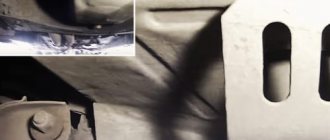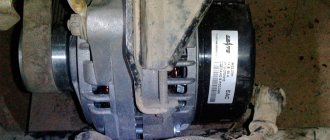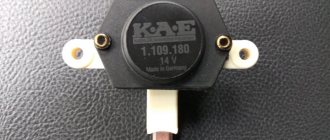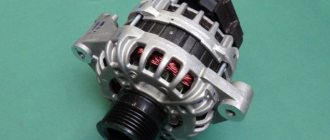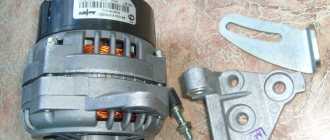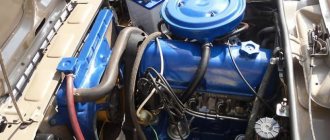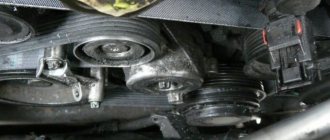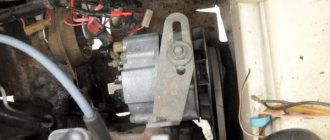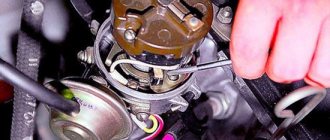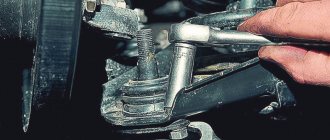In VAZ 2107 cars, the generator unit is the main element of the electrical system, since it is this device that supplies current to all consumers and equipment. Malfunctions in the functioning of the generator device can cause serious inconvenience to the car owner. This material will allow you to learn how to diagnose and how to remove the VAZ 2107 generator to replace it in case of a malfunction.
How to independently replace an old faulty generator with a new one
During the operation of a car, problems associated with a malfunction of the generator often arise.
If any occur, the driver will have to make repairs. First of all, you need to determine the cause of the generator failure. If repairs cannot be performed, you will have to buy a new one and replace it.
Removing the generator. The replacement process, especially on older cars, is quite difficult. You should prepare in advance a set of tools that will be required for this. There are three main ways to remove the generator: pulling it up, pulling it towards you, lowering it, sliding it under the engine, or pulling it out through the wheel arch. Depending on which part of the car we are talking about, you can choose one of these methods.
Experienced drivers can easily remove the element on their own, but beginners will have to contact a car service center so that the center’s employees can help carry out the repair.
The order of actions. In order to avoid any unpleasant and negative consequences, you need to follow a certain procedure, which is important, otherwise it will simply be impossible to achieve the desired result.
So, first of all, you need to disconnect from the engine all elements that may interfere with the removal of the generator itself. Then you need to remove the drive belt from the pulley. As soon as these actions are carried out, it is worth unscrewing the generator mounts. Only by following this sequence of actions can you remove the broken element.
After repair work, it will need to be installed back. If it is impossible to repair the generator, then you need to purchase a new one and install it in the sequence described above.
The thermostat, battery, and various kinds of wires and pipes can become obstacles to successful removal. If there are no markings on the wires, then there may be problems during its connection.
The new generator will allow drivers to continue operating the car without any problems without any serious problems or troubles. Drivers should be more attentive and monitor the technical condition of the car. A faulty generator will not allow the car to be actively used, so drivers will have to carry out repairs.
Conclusion. It is possible to prevent the need to replace a generator with timely prevention and care. But if it was not possible to avoid a breakdown, then it is best to complete all the work in a timely manner.
Source
Common causes of generator failure
Avto-VAZ very often presents car owners with various surprises that arise during operation. One of these is the generator on the Priora, which can hardly maintain 60 thousand kilometers without problems. Once the numbers on the odometer exceed the specified value, malfunctions of this most important component on the car may occur at any time. A faulty generator makes it simply impossible to operate the car, since it does not produce the current necessary to charge the battery. Everyone is familiar with the purpose of a generator on a car, and if there are gaps in memory, then below is material that will help refresh your knowledge.
The service life of generators depends on various factors. This includes the manufacturing quality of the device, operating features, and even work on diagnosing and eliminating minor defects. Typically, their service life on budget cars is at least 5 years or 100-120 thousand kilometers. This is exactly the service life that, in theory, devices on Priors should have, but as mentioned above, these values differ greatly (it is important to note that this is not always the case). This is all due to the quality of the generators that the Priors are equipped with from the factory. These are devices of the famous or “LADA”, problems with which are known not only on the VAZ-2170, but also on other cars from the Russian concern.
Touching upon generator malfunctions on Priora, it should be noted that a common problem is not in the electrical part, but in the mechanical part. The reason lies in the rotor bearing, which, when it fails, produces a characteristic hum and grinding noise, indicating that the car owner is faced with at least the need to dismantle the generator. Such repairs are not at all complicated, but quite labor-intensive for known reasons. The biggest difficulty is removing the generator on the Priora, which is located between the engine and the radiator. Owners of the VAZ-2170, who have had to look under the hood of their car more than once, are well aware that the generator is located in a very limited space, and access to it is closed from all sides.
Interesting! An overtightened alternator belt leads to accelerated wear of the bearings.
The most common reasons why Prior owners need to dismantle the generator are:
- Bearing failure. These elements fail more often than the brushes on the voltage regulator wear out.
- Voltage regulator malfunction. The brushes on the device wear out, and the generated voltage to the battery also drops.
- Worn slip rings or commutator.
- Malfunctions of the diode bridge, which often occurs when moisture gets into the device, and as a result, oxidation appears.
In all of the above situations, you can repair the generator by replacing or eliminating defective elements. If the stator or rotor winding fails, then in such situations the unit must be completely replaced.
Interesting! If it is necessary to replace generator bearings on a Priora, you should choose products of the following types: B17-102DG38 - front support (has the following dimensions: outer diameter - 47 mm, inner diameter - 17 mm, width - 14 mm), 6202DW8 - rear support (outer diameter - 35 mm, internal diameter 15 mm, width - 11 mm).
Replacing the generator: description of the process with comments
Sometimes it happens that a car generator completely fails and cannot be repaired. This happens in two cases, after a serious accident, when the generator housing is broken or when the housing falls apart due to age. In such cases, repairing the generator is impractical and it is easier to replace it with a new one. It also happens that after installing a powerful sound system on a car, the owner begins to notice that the standard generator does not have time to charge the battery. In this case, the generator is replaced with a more powerful one.
Often, old cars have simple and reliable generators that work for decades without replacement. When removing such units, it is often necessary to cut off the fastening elements, as they literally “stick.”
Preparation for repair
As a rule, the need to check the generator appears before repairing it - when the corresponding symptoms appear. Signs that it is not working or its performance has deteriorated significantly are clearly noticeable and understandable even to a non-specialist. How to change and how to check the generator can be read in the relevant literature or look for tips on the Internet, but without experience it is better to entrust this to professionals. These are inexpensive services that will obviously be comprehensive, but will take relatively little time. Please note that these procedures require special equipment and standard tools.
How to remove the generator
Replacing a generator, especially on older cars, is a rather complicated and problematic procedure. You need to stock up on a set of tools in advance that will help you remove the generator from the car yourself. On some foreign cars, the generator can be removed from above, while on others you have to work through the wheel arch or even from below. First you need to decide how it will be easier to remove the generator on a particular car. In order to prevent fasteners from breaking, all fasteners must be treated with WD-40 liquid. To simplify the process of removing the generator, it is advisable to carry out work on a pit or a lift.
Functionality check
Before removing the generator from the Ford Focus 2 for replacement or repair, you should first verify that it is faulty. The verification technology is very simple and fast.
Before diagnosing performance, it is necessary to loosen the positive terminal on the battery.
And then we do this:
- start the engine;
- wait until the speed stabilizes;
- turn on the headlights;
- With the engine running, remove the positive terminal from the battery.
If the generator is working properly, the power plant should not stop; on the contrary, its speed should increase slightly, since the ECU will adjust the operation of the motor to provide the on-board network with energy.
Stopping the unit after removing the terminal will indicate a malfunction of the generator and the need for its repair or replacement. And to do this, the unit needs to be removed from the car, which turns out to be not so easy.
You can use the official instructions, which are presented below, but it does not reflect all the subtleties and nuances of the work, and therefore is more suitable for familiarization than as a detailed guide that everyone can understand.
The procedure for removing the generator with your own hands
When removing the generator, you need to follow this sequence:
- All units that block access to the generator are removed from the engine;
- Remove the drive belt from the generator pulley;
- The generator mounts are unscrewed;
- The generator is removed.
The thermostat, battery, and various wires and pipes may interfere with removal. If you do not mark the wires during removal, problems may arise when connecting the generator (if you have a diagram for installing and connecting the generator, you don’t have to mark the wires).
To remove the generator belt, you need to loosen the generator mount and change the position of the tension roller. After this, you can easily remove the belt. Before you begin the procedure of unscrewing the bolts that hold the generator in place, you should spray the fasteners with Vedashka. If everything is done correctly, the generator can be easily removed from the engine compartment.
How to install headlights on a walk-behind tractor
Headlights are installed on large walk-behind tractors. The generator power is sufficient for installation of equipment and operation of devices. To install headlights, you can purchase a lighting device at an auto parts store or make one yourself.
To do this you need to buy an element for the headlights. If the house has a moped or a car that has spare headlights, then they can be used for installation on a motor cultivator. Then you need to prepare the wire and switch.
First of all, you need to install the switch. Then install the headlight on the steering column or on the front of the engine and install the wiring. If the unit has holes for connecting a headlight, then it must be connected to it. Then the cord is connected to the switch, and from it leads to the headlight. After this, the wiring is connected to the steering column using insulating tape and a prepared clamp.
Will you be able to install (change) a walk-behind tractor generator yourself, or would you prefer to seek help from professionals?
Detailed instructions on how to remove a generator with your own hands using the example of a VAZ 2107 generator
The step-by-step diagram for removing the VAZ 2107 generator looks like this:
- Before starting work, you need to completely de-energize the car; to do this, you just need to remove the negative terminal from the battery;
- The engine protection on the right side and the mudguard are removed;
- You need to disconnect all the wires from the generator, while remembering their location (if you have an installation diagram, you don’t have to remember);
- Now you need to disconnect the generator from the engine housing (this will definitely be difficult);
- We get the generator. If it does not unscrew, fill the fastenings with a wedge and knock out the bolt with a hammer (you don’t need to hit it too hard, otherwise you can tear out the fastenings).
If the bolt does not want to come out, the generator will have to be removed along with its fasteners. To remove the fasteners, you need to unscrew two bolts. Sometimes you come across three-bolt fasteners.
Often, to remove the generator assembly with mountings, you have to remove the cooling radiator. Just don’t take it out and dismantle all the radiator pipes; just move it to the side to gain access to the brackets. Having removed all obstacles, you can easily get the generator with fastenings.
Sometimes the removal and installation of a generator follows a simpler scheme; this happens when replacing a relatively new generator with a more powerful one or when the car is still new. In this case, some specialists manage to pull it out through the right wheel arch. The removal procedure is no different from the above, only you will not need to remove the radiator. To remove the generator through the wheel arch, you need to turn the steering wheel all the way. Before removing the generator, be sure to remove the drive belt from the pulley.
Node malfunctions
Symptoms of a malfunction are:
- Increased noise from under the hood (squealing, squeaking);
- No battery recharging;
- Lack of electricity when using the car’s electrical equipment (the headlights shine dimly, and when they are turned on, the warning lights on the dashboard dim).
At the same time, despite the fact that the generator is connected to the self-diagnosis system, a fault signal is not always displayed on the on-board computer. In this case, the breakdown can be identified experimentally.
Installation of a new generator
The new generator should be installed in accordance with the installation diagram. First, the generator is installed in its place, then the mounting bolts are tightened. Then the generator belt is put on, which will need to be adjusted later, and all the chips and wires are connected. There is no need to put on the protection yet; you will still need to adjust the belt. When carrying out the adjustment procedure, you must tension the belt strictly according to the installation instructions.
Manufacturers of automobile generators
Foreign and domestic cars are equipped with generators of both our own production and third-party manufacturers. Replacing a product with a similar one from a different manufacturer is possible with compatible mounting, power, similar parameters of the generated current, dimensions and belt drive pulley. Most often, generators from the following companies are installed on cars:
- Bosch. Installed on most European car brands. It is characterized by simplicity of the device and reliability.
- Cargo. Danish company specializing in the production of starters and generators. It supplies products to many automakers, the price of the products is slightly cheaper than the original.
- Delco Remy. An American manufacturer present on the automotive components market for more than a hundred years. The products are of impeccable quality and durability, possessing all the necessary international certificates.
- Lucas. Large British manufacturer of original quality car parts.
- Magneton. Czech manufacturer specializing in the production of starters and automobile alternators. The products are characterized by an optimal price-quality ratio.
- Valeo. A French concern formed as a result of the merger of several companies producing generators and other components for cars. The product is structurally and operationally similar to Bosch.
Features of adjusting the alternator belt
For stable operation of the generator, the drive belt must be tensioned in accordance with the manual. Weak tension will lead to belt slipping, and the battery will not be fully charged, which will lead to its failure. With increased energy consumption, the battery may run out even during a short stop.
The procedure for adjusting belt tension takes no more than 15 minutes (if you have experience). You should not give money to a service station; this procedure is done with a pair of wrenches.
- You need to slightly loosen the locknut on the tension bar. If this is not done, you will not be able to turn the adjusting bolt. If the washer reservoir is in the way, you can dismantle it, but this is not a prerequisite;
- By rotating the tensioner bolt, you should achieve the optimal tension moment for the alternator V-belt;
- At the end of the procedure, all you have to do is firmly tighten the locknut on the tension bar;
- All that remains is to check the belt tension.
The inspection procedure must be carried out without fail to ensure that the belt tension has been carried out correctly. You need to turn on the ignition and inspect the dashboard, where the battery charging light should light up. After this, you need to start the engine and let the car idle. If the battery charge light goes out after a few seconds, the belt is tensioned correctly. If the light comes on and goes off periodically, then you should tighten the belt more.
Even a novice car enthusiast can adjust the belt. The main thing is to strictly follow the instructions and diagnose the belt tension.
Replacement of the generator can be avoided if preventive maintenance of this unit is carried out in a timely manner. You should not remember about the generator when it completely stops doing its job, otherwise even a new battery can be damaged.
Source
Difference between single and three phase connection
All connections, whether in a single-phase or a three-phase network, are made completely identical, with the exception of the number of power wires. The only important nuance concerns the so-called control phase - if you connect the starter to the network, then its main contacts connect and disconnect the power wires from the network, and the power for the electromagnetic coil must also be taken from somewhere.
In a single-phase network there are no problems - there is only one phase and such a question simply does not exist, but in a three-phase network everything is somewhat more complicated - there are L1, L2 and L3. Without going into technical details, there is only one answer - for control circuits you can use any of the phases, but only one. That is, if the KM1 coil is powered from phase L3, then the control of the remaining starters, the “Start” and “Stop” buttons must also be “hung” only on it.
This is not difficult to do - just note what color the wire is on the desired phase, and if the cable has single-color conductors, then stick or draw markers on them.
Implementation of the generator and its operating principle
Thanks to electromagnetic induction, an electric current is generated in the generator. This happens because the winding moves in an artificially created magnetic field. This is the principle of operation of an electric generator.
The generator is driven by a low-power internal combustion engine. It can run on gasoline, gas or diesel fuel.
An electric generator has a rotor and a stator. The magnetic field is created using a rotor. Magnets are attached to it. The stator is the stationary part of the generator, and consists of special steel plates and a coil. There is a small gap between the rotor and stator.
General design of the device
Automobile generators are produced in compact and traditional forms, differing in size, housing design, fan layout, drive pulley and rectifier assembly. Moreover, all devices have the following common components:
- Frame. Serves to accommodate most of the structural elements of the device. It consists of a front and back cover connected to each other by bolts, which are made of a non-magnetic alloy that easily gives off heat. Ventilation windows are made on the surface and mounting paws are provided.
- Rotor. Designed to create a rotating magnetic field. For this purpose, an excitation winding is mounted on its shaft, which is placed in two pole halves. At the end of the shaft there are two slip rings for powering the field winding. Most rotors have a fan impeller and a drive pulley on the shaft. The shaft itself rotates on a pair of ball or roller maintenance-free bearings.
- Stator. Designed to generate alternating current, and structurally includes a metal core with windings. The core is made of steel plates, in which 36 grooves are made for the windings. The 3 windings placed in them form a three-phase voltage.
- Brush unit. Transfers excitation current to slip rings. It consists of two brushes made of graphite, which press springs, and a brush holder. On new types of generators, the brush assembly and voltage regulator are mounted in a single non-separable housing.
- Rectifier. Converts the alternating voltage generated by the generator into direct current of the on-board network. Structurally, it is made on heat sink plates with mounted power diodes.
- Voltage regulator. Maintains the generator voltage within specified limits, stabilizes it at different engine speeds, and also changes the battery charging voltage based on the air temperature (the lower the temperature, the higher the voltage).
- Generator drive. It is made in the form of a pulley, connected to the crankshaft by a V-belt or poly V-belt and rotates 2-3 times faster than the engine crankshaft.
Build process
Everything is simple here! Capacitors are connected to the electric motor in a delta configuration. During operation, you need to periodically check the temperature of the case. Its heating may occur due to incorrectly selected capacitor capacitors.
A homemade generator that does not have automation must be constantly monitored. Heating that occurs over time will reduce efficiency. Then the device needs to be given time to cool down. From time to time you should measure the voltage, speed, and current.
Incorrectly calculated characteristics are not able to give the equipment the necessary power. Therefore, before starting assembly, you should carry out drawing work and stock up on diagrams.
It is quite possible that a homemade device will experience frequent breakdowns. This should not be surprising, since it is practically impossible to achieve a hermetically sealed installation of all elements of an electric generator at home.
So, I hope it’s now clear how to make a generator from an electric motor. If you want to design a device whose power should be enough to simultaneously operate household appliances and lighting lamps, or construction tools, then you need to add up their power and select the desired engine. It is desirable that it has a small power reserve.
If you fail when manually assembling an electric generator, do not despair. There are many modern models on the market that do not require constant supervision. They can be of different power, and are quite economical. There are photos of generators on the Internet; they will help you estimate the dimensions of the device. The only negative is their high cost.
Source
What's wrong?
After eliminating possible problems with the car's electrical system and other defects, you can proceed to a detailed check of the starter and/or generator.
Diagnosis of a dead starter is simple. It is disassembled and defective. In addition to dead parts, it is important to update elements with significant wear so that you don’t have to open the unit again soon. Along the way, check the resistance of the windings of the solenoid relay and the Bendix for failure.
With modern generators it is more difficult. In their design, the relay-regulator is connected via a separate bus to the “brain” of the engine, providing a smart charging function. The trouble is that to check a relay from a specific manufacturer, you most often need an individual diagnostic device with an oscilloscope. It also allows you to check the regulator separately from the generator - this saves repairmen from defective relays.
The generator is also checked on the stand. Its behavior under load, in idle mode and during heating is assessed. Additionally, the noise of the bearings is listened to with a stethoscope.
Bench tests are carried out before and after generator repair.
